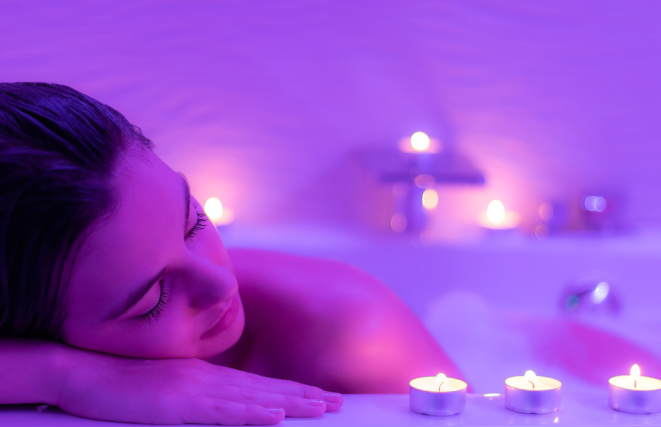Scientific studies suggest that incorporating some relaxation techniques could activate a response process that could help with your sleep quality (Newson & Rehman, 2024).
The power of massage for sleep quality
Massage therapy has been practiced for centuries as a way to promote relaxation. For instance, an example of this is the Kanpumasatsu, a Japanese self-care massage that involves rubbing the skin with a dry towel, that could promote relaxation. This simple, safe, and cost-effective practice could easily be incorporated into nightly routines (Komagata, 2023).
Another massage technique that could promote relaxation is Shirodhara, a traditional Ayurvedic therapy involving the steady flow of warm oil on the forehead, practiced frequently in India and the United States. A Shirodhara session could last between 30 to 60 minutes and could be conducted over a period of 3, 7, 14, or 28 days (Vinjamury et al., 2014).
In addition, facial and foot massage therapy could induce a state of calm and relaxation (Ejindu, 2007).
Visualization and breathing exercises
While different massages could promote relaxation, combining them with visualization and breathing exercises could further optimize your sleep quality. Visualization involves imagining calming scenes or scenarios that could help distract your mind, while breathing exercises could help regulate your breathing patterns and promote calmness (Newsom & Rehman, 2024).
Slow breathing for calmness
One effective technique could be 4-7-8 breathing. To practice this, inhale through your nose for four seconds, hold your breath for seven seconds, and then exhale slowly through your mouth for eight seconds. Repeat this cycle four times. This exercise could trigger a relaxation response, making it easier to drift off to sleep. If you decide to practice this, it is important to know that you should go at your own pace! (Newsom, & Rehman, 2024).
Visualization techniques
Imagine a peaceful place where you feel safe and content, such as a beach, a forest, or a mountaintop. Focus on the details, like the sound of waves, the rustle of leaves, or the warmth of the sun on your skin. By concentrating on these types of scenarios, you could distract your mind from worries that may keep you awake (Newsom & Rehman, 2024).
The science behind relaxation techniques
But why are these techniques effective? The answer lies in the connection between your mind and body. When you’re not calm, your body enters a state of heightened alertness. This state makes it completely difficult to fall asleep (Newsom & Rehman, 2024).
Optimizing your rest could be easy!
Before trying relaxation techniques to help you fall asleep, here are some final tips to consider:
- Be consistent: The regular use of these relaxation techniques could be more effective than trying them just once or for a short period of time (Newsom & Rehman, 2024)
- Be open to adjustments: This could involve some trial and error, so if one method doesn’t help, don’t hesitate to try another! (Newsom & Rehman, 2024).
- Minimize sleep disturbances: You could achieve this by maintaining a quiet, dark, and comfortably cool room, free from distractions (Newsom & Rehman, 2024).
By integrating simple massage techniques and relaxation exercises into your nightly routine, you could create a peaceful environment that encourages you to feel relaxed, making it easier to fall asleep. Remember, the key is to be consistent and patient. With time, these practices could help you relax and achieve the restorative sleep you need. (Newsom, Rehman, 2024)
Sources:
1. Ejindu, A. (2007). The effects of foot and facial massage on sleep induction, blood pressure, pulse and respiratory rate: Crossover pilot study. Complementary Therapies In Clinical Practice, 13(4), 266-275. https://doi.org/10.1016/j.ctcp.2007.03.008
2. Komagata, S. (2023). Kanpumasatsu: A superficial self-massage with a dry towel to enhance relaxation and immune functions. Journal Of Interprofessional Education & Practice, 31, 100609. https://doi.org/10.1016/j.xjep.2023.100609
3. Newsom, R., Rehman, A. (2020, December 18). Relaxation Exercises to Help Fall Asleep. Sleep Foundation. https://www.sleepfoundation.org/sleep-hygiene/relaxation-exercises-to-help-fall-asleep
4. Vinjamury, S. P., Vinjamury, M., Martirosian, C. D., & Miller, J. (2014). Ayurvedic therapy (Shirodhara) for Insomnia: A Case Series. Global Advances In Health And Medicine, 3 (1), 75-80. https://www.ncbi.nlm.nih.gov/pmc/articles/PMC3921608/
